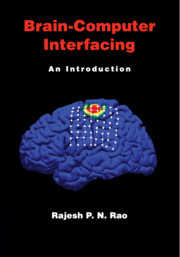6 - Building a BCI
from Part II - Putting It All Together
Published online by Cambridge University Press: 05 October 2013
Summary
The preceding chapters introduced you to the basic concepts in neuroscience, recording and stimulation technologies, signal processing, and machine learning. We are now ready to put it all together to consider the process of building an actual BCI.
Major Types of BCIs
BCIs today can be broadly divided into three major types:
Invasive BCIs: These involve recording from or stimulating neurons inside the brain.
Semi-invasive BCIs: These involve recording from or stimulating the brain surface or nerves.
Noninvasive BCIs: These employ techniques for recording from or stimulating the brain without penetrating the skin or skull.
Within each of these types, we can have BCIs that:
Only record from the brain (and translate the neural data into control signals for output devices).
Only stimulate the brain (and cause certain desired patterns of neural activity in the brain).
Both record and stimulate the brain.
In the next i ve chapters, we will encounter concrete examples of the major types of BCIs defined above. Before we proceed to these concrete BCI examples, it is useful to first discuss some of the major types of brain responses that researchers have exploited for building BCIs.
- Type
- Chapter
- Information
- Brain-Computer InterfacingAn Introduction, pp. 101 - 106Publisher: Cambridge University PressPrint publication year: 2013

